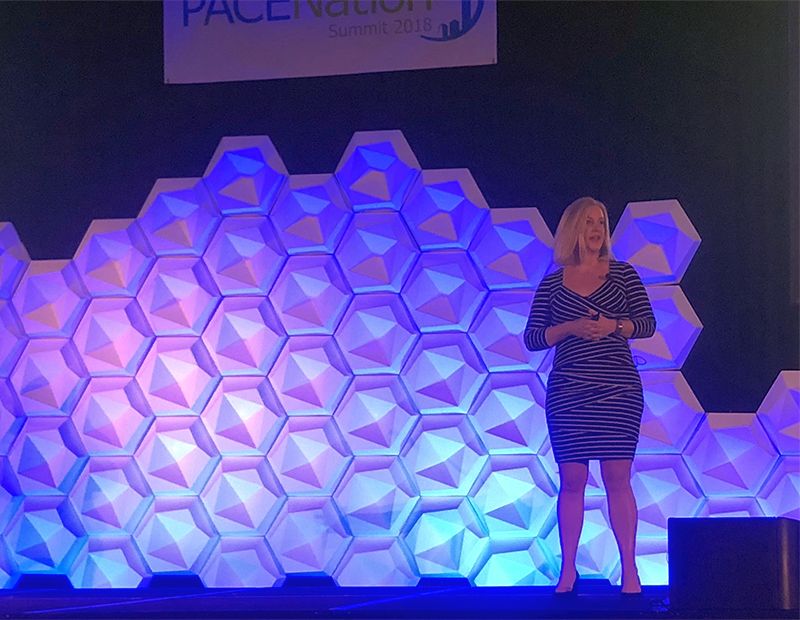How Can PACE Financing Boost Solar’s Growth?
At the PACENation Summit in Denver, SEIA President & CEO Abigail Hopper addressed PACE's potential, strategies for expanding solar, tariffs and more.
By Justin Dean

In her keynote address at the PACENation Summit in Denver, SEIA President & CEO Abigail Hopper talks about the potential of the PACE program to open new markets.
Day two of the PACENation Summit kicked off in Denver on March 20 with a keynote address from Abigail Hopper, president & CEO of SEIA, the national trade association for the solar industry. Hopper spoke on the present and future of the solar market before shifting her focus to ways that the solar industry and PACE have worked together, and how they can grow and enhance the relationship between the two industries in the future.
It has been a turbulent year for the solar industry. The current White House is more inclined to support traditional forms of energy, a position made abundantly clear when the Trump Administration announced a 30 percent tariff on solar imports in January of this year. Solar installations fell sharply in 2017, although a hefty portion of that can be attributed to the anticipation of an expiring tax credit that accelerated installation for much of 2016. Hopper also cited a “playbook on how to undermine solar” for the opponents of the solar industry to follow when engaging with state and local governments, which has arisen over the last couple of years. This is to be expected. As solar is beginning to eat into the market share of traditional energy companies, push-back was inevitable.
Despite all of this, Hopper said she remains “incredibly optimistic” about the solar industry, believing it can generate 15 percent of U.S. energy by 2030. Much of this optimism comes from simple economics. Solar installations are moving from a “policy-driven energy source to an economic-driven energy source,” she said. Prices for photovoltaic (PV) cells have fallen drastically during this decade and are projected to fall further in the future.
However, there may be more potential for solar price reduction in the so-called “soft costs,” which include costs for labor, permitting, marketing, financing, supply chain and overhead. As the industry matures, there is potential for each of these costs to shrink on a per-watt-generated average as methods are standardized, new efficiencies are discovered and economies of scale are realized. The costs of solar projects as a whole should continue to decline and benefits grow due to increases in the storage capacity of batteries. Currently, in both single and multifamily residential solar projects, most of the electricity is generated during the day, when it is sunny but people are at work. As storage capacity of batteries rises, so does the potential for a solar project to save the electricity generated during the day for the evening, when people consume most of their residential electricity.
Proactive Pursuits
Hopper listed the three key areas where the industry must be proactive to ensure that solar achieves a 15 percent market share by 2030:
- The industry needs to promote free and fair trade. This is obvious in light of the recent announcement of tariffs on imported solar panels and will be one of the biggest fights in the next few years.
- The solar industry needs to defend the “critically important” investment tax credit that makes many of these projects feasible. While PACE is a powerful tool that enables many property owners to finance the installation of solar panels, many projects would be less attractive without the tax credits that provide savings that help offset some of the costs.
- It is important for the industry to protect net metering and work with stakeholders on the future of utility rate design. Net metering, which allows solar system owners to receive a credit for electricity that they add to the grid, is a critical benefit for many when weighing whether or not to move forward with an installation.
Hopper was also very optimistic that the PACE program would open new markets and create opportunities for the solar industry that had previously been lacking. Simply increasing the number of states that allow commercial PACE would open many untapped markets. Increasing education about PACE financing is another type of low-hanging fruit that could accelerate the velocity of installations in many places across the country.
More complex but equally impactful opportunities also exist. Some states have commercial PACE laws on their books, but issues with the solar power purchase agreements have held up projects until this point. As for community solar projects, Hopper believes there is a glut of potential and that PACE financing, be it residential PACE for neighborhoods or commercial PACE for multifamily, may be able to assist in getting them off the ground. However, this solution still requires exploration and experimentation.







You must be logged in to post a comment.